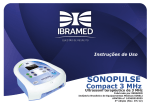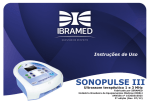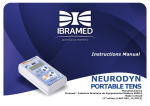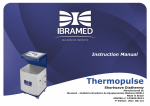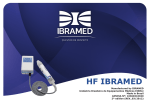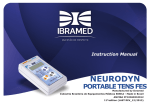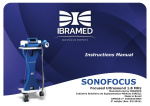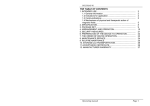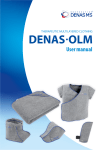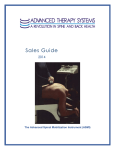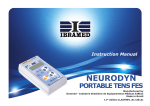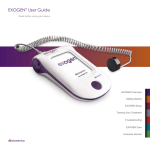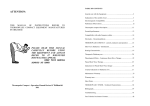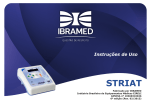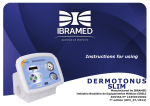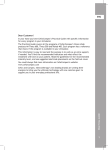Download Manual - Ibramed
Transcript
Instructions Manual SONOPULSE Compact 1 MHz Therapeutic Ultrasound 1 MHz Manufactured by Ibramed Indústria Brasileira de Equipamentos Médicos EIREILI. Made in Brazil ANVISA Nº 10360310025 4th edition (REV_07/2012) TABLE OF CONTENTS SYMBOL DEFINITIONS..........................................3 ACCESSORIES USED..........................................31 CARTON......................................................4 OPERATION INSTRUCTIONS................................32 ABREVIATIONS GLOSSARY.....................................5 PROGRAMMING THE EQUIPMENT..........................36 FIGURES GLOSSARY.............................................5 DIRECTIONS ON ULTRASOUND ...........................37 FOREWORD.........................................................6 TECHNICS OF ULTRASOUND APPLICATION ............38 PRODUCT DESCRIPTION.......................................6 COMBINED THERAPY USING SONOPULSE Compact ESSENTIAL PERFORMANCE ............................6 1 MHz..............................................................39 SAFETY PRECAUTIONS..........................................7 USING THE PROG/MENU KEYS............................42 INDICATIONS AND PRECAUTIONS..........................9 CLINICAL CONTRA INDICATIONS AND ADVERSE REACTIONS..10 PROTOCOLS......................................................44 POPULATION AND CONDITIONS OF USE................11 REFERENCES.....................................................57 RESPONSIBILITY ACCESSORIES FOR USE ELECTROMEDICAL RESOURCES WHICH LIBRARY ACCOMPANY - CLINICAL SONOPULSE EQUIPMENT.......................................................12 Compact 1 MHz................................................59 GENERAL EQUIPMENT CARE.................................13 TROUBLESHOOTING ..........................................61 SHIPPING DAMAGE.....................................13 MAINTENANCE, INSTALLATION, CARE AND CLEANING............13 SUPPORT...........................................................61 ELECTROMAGNETIC COMPATIBILITY GUIDANCE......16 CEFAI – IBRAMED Center for Education and SPECIFICATIONS................................................24 Advanced Training.........................................64 SYSTEM SPECIFICATIONS............................24 SPECIFICATIONS OF ULTRASOUND................25 NOMENCLATURE.................................................26 DEFINITION OF SYMBOLS....................................29 2 WARRANTY AND TECHNICAL SYMBOL DEFINITIONS BELOW ARE THE DEFINITIONS OF THE SYMBOLS USED ON THE EQUIPMENT AND THROUGHOUT THE INSTRUCTIONS FOUND IN THIS MANUAL. UNDERSTAND THESE SYMBOLS AND THEIR DEFINITIONS BEFORE OPERATING THIS EQUIPMENT Caution! Refer to user manual. Combined therapy IN. CLASS II Electrical equipment. Off Switch. Protected against dripping water. On Switch. Protected against the effects of immersion. Start treatment. TYPE BF Electrical Equipment. Stop treatment. Dangerous Voltage. Alternating Current. Transducer. 3 SYMBOLS DEFINITIONS CARTON Fragile. Refer to operating correct product use. This side up. Manufacturer’s name and address. Limits of temperature for storage and packaging in °C (Celsius Degrees). Keep away from the rain. Stacking up. Do not use damaged. if the packaging is 4 instructions for FIGURES GLOSSARY ABREVIATIONS GLOSSARY MHz Megahertz (million pulses (106) by second) Figure 1. Upper view................................................26 ERA Effective Radiating Area Figure 2. Rear view..................................................26 W Watt (s) Figure 3. Frontal view...............................................27 W/cm2 Watt (s) per square centimeter cm2 Square centimeter Figure 4. Lower view.................................................27 Figure 5. A, Ultrasound transducer with ERA of 7 cm2; B, VA Volt Ampere neutral conductor gel. ...........................................31 BNR Beam Non-Uniformity Ratio Figure 6. A, presentation message; B, standard/default Min Minute SONOPULSE Compact 1 MHz screen........................32 Figure 7. Application technique with ERA of 7 cm2.............38 Figure 8. A, slot for combined therapy of SONOPULSE Compact 1 MHz; B, connector cable for combined therapy...................................................................39 Figure 9. Application technique for combined therapy.......41 Figure 10. Message of selection of language.....................42 Figure11. Programmed and User protocols display........43 5 FOREWORD PRODUCT DESCRIPTION ESSENTIAL PERFORMANCE SONOPULSE Compact 1 MHz is a therapeutic ultrasound micro controlled device in the frequencies of 1 MHz, designed to be used for aesthetic and physiotherapy treatments. SONOPULSE Compact 1 MHz allows the choice of ERA (Effective Radiating Area) of 7 cm2, 1 MHz frequency with the ERA 7 cm2. The average ultrasound output power is 21 Watts for the ERA of 7 cm2, therefore, the maximum intensity is 3 W/cm2. The ultrasound emission mode can be adjusted to continuous or pulsed. The pulsed mode has pulse repetition frequencies of 100 Hz, 48 Hz or 16 Hz, with pulse ratio of ½ (50%) 1/5 (20%) or 1/10 (10%). SONOPULSE Compact 1 MHz also has a PROG key, which allows the choice of pre programmed treatment programs (recorded on the memory of the device). SONOPULSE Compact 1 MHz must be used with complaint gel. The wavelength of 1 MHz penetrates to a depth of approximately 5 cm. This device must be used only under prescription and supervision of a licensed professional. This user manual allows the user to efficiently use the SONOPULSE Compact 1 MHz. It also gives suggestions for treatment protocols so that you can use your equipment to its full potential. Consult other resources for additional information regarding the uses of ultrasound before attempting any treatment on a patient. Users must read, understand and follow the information in this manual for each mode of treatment available, as well as the indications, contra indications, warnings and precautions. The specifications and instructions in this manual are in effect at the time of its publication. These instructions may be updated at any time at the manufacturer’s discretion. Visit our web site for updates. 6 SAFETY PRECAUTIONS PRECAUTIONARY DEFINITIONS The precautionary instructions found in this section and throughout this manual are indicated by specific symbols. Understand these symbols and their definitions before operating this equipment prior to therapy session. • Read, comprehend and practice the precaution and operation instructions. Know the limitations and dangers associated with the use of any electrical stimulation. Observe the precaution and operation labels placed on this unit. • Do not operate this unit in an environment where other devices intentionally radiate electromagnetic energy in an unprotected manner. • Check the cables and connectors before each use. • The SONOPULSE Compact 1 MHz stimulator is not designed to prevent the penetration of water and other liquids. Penetration of water and other liquids may cause malfunction of the internal components of the system, and consequently, promote risk of injure to the patient. • Disconnect the plug from the power outlet when the device is not used for long periods of time. • The applicator should be operated only by the handle to avoid exposure to unwanted emission of ultrasound. Text with a “CAUTION” indicator refers to potential safety infractions that could cause minor to moderate injury or damage to equipment. Text with a “WARNING” indicator refers to potential safety infractions that could cause serious injury and equipment damage. Text with a “DANGER” indicator refers to potential safety infractions that represent immediately life threatening situations that would result in death or serious injury. 7 SAFETY PRECAUTIONS • In order to be protected from the risk of fire, use only spare fuses of the same type and class. • Make sure the unit is grounded, connecting it to a grounded power outlet in conformity with the applicable local and national electrical codes. • Before treating the patient, it is necessary to know the operational procedures for each treatment mode available, as well as the indications, contra indications, warnings and precautions. Refer to other sources to obtain additional information on electrotherapy applications. • To avoid electrical shock, turn the device off the power supply line before any maintenance procedure. • The ultrasound treatment must not be applied on swollen infected or inflamed areas, or on skin eruptions such as phlebitis, thrombophlebitis, varicose veins, etc. • Ultrasound treatment must not be applied on or next to cancerous lesions. • Patients with neurostimulation devices or implanted pacemakers must be distant from any shortwave diathermy, microwave diathermy, therapeutic ultrasound diathermy, or laser diathermy and must not be treated with these on any part of their bodies. The diathermy energy (shortwave, microwave, ultrasound and laser) may be transferred through the implanted neurostimulation system, and it may cause damage to the tissues, and result in serious injury or death. Damage, injury and death may occur during diathermy therapy even if the implanted system is turned off. • Equipment not suitable for use in the presence of a flammable anesthetic mixture with air, oxygen or nitrous oxide. Equipment is not the AP or APG category. 8 INDICATIONS AND PRECAUTIONS INDICATIONS PRECAUTIONS • Ultrasound treatment must be avoided over the stellate ganglion, spinal cord after laminectomy, when great tissue resections have been performed, under subcutaneous major nerves and the cranium. • Ultrasound must not be applied in areas of reduced sensation or circulation or over anesthetic areas. Patients with reduced sensation are not capable of warning the professional in case there is discomfort and in patients with compromised circulation there may be an excessive buildup of heat in the treated area. • Patients with hemorrhagic diastheses or hemorrhagic disorders must be treated with care. • Professionals operating the device on a daily basis must not be exposed to therapeutic ultrasound. The applicators handles have been developed to allow the professional to protect the hands from ultrasound when performing underwater treatment. • If a patient complains of deep periosteal pain during ultrasound treatment, the intensity should be reduced to a comfortable level. • Heating must be avoided during the acute or sub-acute phase of arthritis. • Other treatments with electronic devices or hydro massage devices which may come into contact with the patient during ultrasound therapeutic treatment must be appropriately tested to assure the safety of the operation. • The operator should manipulate the applicator only by handle during the application. Therapeutic ultrasound is commonly indicated for: • Pain relief • Reduction of muscle spasm • Localized increase in blood flow • Increase in range of motion in contracted joints using heat associated with stretch techniques.. Relief of pain, muscle spasms and contracted joints may be associated with: • Adhesive capsulitis. • Bursitis with mild calcification. • Myositis. • Lesion of soft tissues. • Post lesion shortening of tendons and scar. Relief of chronic pain and muscle contracture may result from: • Capsular tension. • Capsular scar. 9 CONTRA INDICATIONS AND ADVERSE REACTIONS CONTRA INDICATIONS • Therapeutic ultrasound must not be applied over the pregnant uterus or potentially pregnant uterus. • Therapeutic ultrasound must not be applied for undiagnosed pain. • Therapeutic ultrasound must not be applied over neoplastic areas or over areas from which tumors have been removed. • Therapeutic ultrasound must not be applied over the eyes. • Therapeutic ultrasound must not be applied on ischemic tissues, where the blood supply may be incapable of following the increase in metabolic demand and result in necrosis. • Therapeutic ultrasound must not be applied over bone growth centers. • Ultrasound therapy is not recommended for patients with implanted electronic devices (cardiac pacemakers, deep brain stimulation devices). • Do not apply ultrasound over areas previously treated with radiotherapy. • Ultrasound must not be applied over the testes, to avoid increases in temperatures. • Ultrasound must not be applied over the heart. • Therapeutic ultrasound must not be applied over areas of thrombophlebitis deep vein thrombosis emboli and severe atherosclerosis. • Therapeutic ultrasound must not be applied in case of suspected serious infectious disease and in diseases in which, for general medical purposes, it is advisable to suppress heat and fever. ADVERSE REACTIONS • Therapeutic ultrasound, when applied in continuous circular movements, may cause a sensation of numbness and/ or heat. If, however, the applicator is kept over the same place for more than a few seconds in high energies, it may become uncomfortable. 10 POPULATION AND CONDITIONS OF USE PATIENT POPULATION • Patients over 12 years old, under this age only by medical prescription or physiotherapeutic indication; • Patients over 35 kg, under this weight only by medical prescription or physiotherapeutic indication; • There are no restrictions as of nationality; • Patients with preserved level of conscience and sensitivity. • There are no admissible deficiencies for the use of the equipment; • Regarding the frequency of use, this device is used according to clinical needs, up to several times a day and is reusable; • Regarding mobility, this device is considered a portable device. CONDITIONS OF USE • There are no requisites about a maximum level of education for the intended use. • Regarding the minimum level of knowledge of the user, it is necessary that the user knows the electro physical agents and their therapeutical effects. The user must know physiology, anatomy, and the basic sciences: chemistry, physics, and biology. The user is supposed to have studied or be presently studying physiology and anatomy; • A maximum level of knowledge is not required from the user; • The instructions of use are available in Portuguese, Spanish and English; • Regarding the minimum level of experience of the user, it is necessary that the instructions of use are read carefully and all the instructions are understood before the use of the device; 11 RESPONSIBILITY FOR USE ELECTROMEDICAL EQUIPMENT The use of electromedical equipment is restricted to a physician or under his command, the physical therapists or health professionals properly licensed. The professional will be responsible for properly licensed use and operation of the equipment. IBRAMED makes no representations regarding laws and federal, state or local laws that may apply to the use and operation of any electromedical equipment. The physician or under his command, also the physical therapist or other professional health care licensed assumes total and full commitment to contact the local certifying agencies to determine any credential required by law for clinical use and operation of this equipment. The use of electromedical equipment must comply with the local, state and federal country. 12 GENERAL EQUIPMENT CARE SHIPPING DAMAGE INSTALLATION, CARE AND CLEANING Your SONOPULSE Compact 1 MHz is shipped complete in Installation Instructions one carton. Upon receipt, inspect carton and unit for visible 1. Connect the line cord to the back of the SONOPULSE Compact 1 MHz. 2. Plug the line cord into a grounded wall outlet (100-240V ~ 50/60 Hz). 3. Plug the ultrasound cables into the correct connections. 4. Switch on your equipment. and hidden damage. In case of damage, keep all shipping materials including carton and contact the shipping agent responsible for the delivery of the unit. All claims relating to damage during transport should be filed directly with them. The manufacturer will not be liable for any damage during shipping, nor allow for adjustments unless proper formal claim has been filed by the receiver against the carrier. The carton in which your SONOPULSE Compact 1 MHz was received is specially designed to protect the unit during shipping. Please keep all shipping materials in case you need to return your unit for servicing. 13 GENERAL EQUIPMENT CARE SONOPULSE Compact 1 MHz Care Instructions ENVIRONMENTAL PROTECTION • Avoid areas subject to vibrations. • Install the equipment on a firm and level surface, in open air. • Do not block ventilation. • Avoid humid, hot and dusty environments. • Make sure the area around the network cable is free. • Do not insert objects into device holes. The SONOPULSE Compact 1 MHz is an electronic device and has heavy metals such as lead. Thus, there are risks of contamination to the environment associated with the disposal of this equipment and its accessories at the end of their useful lives. The SONOPULSE Compact 1 MHz, parts and accessories must be disposed of as waste. Contact your local distributor for information on rules and laws regarding the disposal of waste electrical, electronic equipment and accessories. Proper installation, operation and maintenance of the equipment prevents security risks. Cleaning the SONOPULSE Compact 1 MHz THE DEVICE AND ITS CONSUMABLE PARTS MUST BE DISPOSED OF, AT END OF LIFE, • Disconnect the system from the power source, wipe with a clean, lint free cloth moistened with water and mild antibacterial soap. • If a more sterile cleaning is needed, use a cloth moistened ACCORDING TO THE APPLICABLE FEDERAL AND/OR STATE AND /OR LOCAL REGULATIONS. with an antimicrobial cleaner. • Do not place the system in liquids. 14 GENERAL EQUIPMENT CARE ELECTRICAL FEED SONOPULSE Compact 1 MHz is a protective CLASS II device with applied part type BF of safety and protection. SONOPULSE Compact 1 MHz works in power supply tension in the range of 100 - 240V ~ 50/60 Hz. Just connect the device to the power line and it will perform the selection of power tension automatically. The connector cable to the power supply line is detachable. The device uses the power line plug as a resource to electrically separate its circuits in relation to the power supply line in all poles. • • • NOTES • In the rear part of SONOPULSE Compact 1 MHz there is a protection fuse. To replace it, turn the device off the power supply line and with the help of a screwdriver, remove the protection lid, disconnect the fuse, perform the replacement and reinsert the lid. Always use the fuses indicated by IBRAMED. Use a fuse for nominal current of 5.0A, operation tension of 250V~ and snap action model 20AG (50A rupture current). Before turning on SONOPULSE Compact 1 MHz make sure: The tension and frequency of the local power supply line of the establishment where the device is installed are equal to the one described on the label describing characteristics of tension and power located at the rear part of the device. To prevent electrical shock, do not use the plug in the device with extension cables, or any other types of sockets except the terminals connect perfectly in the receptacle. Cleansing and disinfection must always be performed with the power plug off of the power supply line. Maintenance and technical assistance of SONOPULSE Compact 1 MHz must always be performed at unauthorized service, only by qualified technicians. Inside the device there are dangerous tensions. Never open the device. SONOPULSE Compact 1 MHz does not need any type of power stabilizer. Never use a power stabilizer. 15 ELECTROMAGNETIC COMPATIBILITY GUIDANCE POTENTIAL ELECTROMAGNETIC INTERFERENCE • This unit is not designed to be used where there is explosion hazard, such as anesthesia departments or in the presence of an anesthetic flammable when mixed with air, oxygen or nitrous oxide. As for the limits of electromagnetic interference, SONOPULSE Compact 1 MHz is an electromagnetic device of Group 1 Class A. The simultaneous connection from the patient to SONOPULSE Compact 1 MHz and to high frequency surgical equipment may result in burns in the ultrasonic transducer application area and possible damage to the device. Short distance operation (1 meter, for example) of short wave or microwave therapy equipment may produce instability in the output of the device. To prevent electromagnetic interference, we suggest that one group of power supply line is used for SONOPULSE Compact 1 MHz and another separate group is used for short wave or microwave equipment. We also suggest that the patient, SONOPULSE Compact 1 MHz e and connection cables are installed at least 3 meters away from short wave and microwave therapy equipment. • Using cables, electrodes and other accessories from other manufacturers and/or different from those specified in this manual as well as the replacement of internal components SONOPULSE Compact 1 MHz may result in increased emissions or decreased immunity of the equipment. • SONOPULSE Compact 1 MHz equipment is intended for use only by health care professionals. The SONOPULSE Compact 1 MHz may cause radio interference or disrupt equipment operations nearby. It may be necessary to adopt mitigation procedures, such as reorienting or relocating the equipment or shielding of the site. • Portable and Mobile Radio Frequency (RF) communications Medical Electrical Devices requires special attention regarding Electromagnetic Compatibility (EMC) and must be installed and put into service according to the EMC information provided in the following tables. equipment can affect Medical Electrical Devices. 16 ELECTROMAGNETIC COMPATIBILITY GUIDANCE Manufacturer’s guidelines and declaration – Electromagnetic emissions SONOPULSE Compact 1 MHz is destined to be used in the electromagnetic environment specified below. The user of the equipment should be sure that it will be used in this environment. Emission test Conformity RF Emissions NBR IEC CISPR 11 IEC CISPR 11 Group 1 RF Emissions NBR IEC CISPR 11 IEC CISPR 11 Class A Harmonic Emissions IEC 61000-3-2 Emissions due to the fluctuation/ scintillation Class A Electromagnetic emissions SONOPULSE Compact 1 MHz emits RF energy only for its internal functions. However, its RF emissions are very low and it is unlikely to cause any interference in nearby electronic equipment. SONOPULSE Compact 1 MHz is suitable to be used in all kinds of places other than residential and which are not directly connected to the public distribution of low voltage which supplies the domestic buildings. Class A IEC 61000-3-3 17 ELECTROMAGNETIC COMPATIBILITY GUIDANCE Manufacturer’s guidelines and declaration – Electromagnetic immunity SONOPULSE Compact 1 MHz is destined to be used in the electromagnetic environment specified below. The user of the equipment should ensure that it is used in such environment. Immunity Test Electrostatic discharge (ESD) IEC 61000-4-2 Fast electric transitories / pulse train (Burst) IEC 61000-4-4 Outbreaks IEC 61000-4-5 Test level IEC 60601 Conformity level ± 6 kV by contact ± 6 kV by contact ± 8 kV by air ± 8 kV by air ± 2 kV in the feeding lines ± 2 kV in the feeding lines ± 1 kV in the input/output lines ± 1 kV in the input/output lines ± 1 kV diferencial mode ± 1 kV diferencial mode ± 2 kV common mode ± 2 kV common mode 18 Electromagnetic environment – orientations The floor should be wooden, concrete or ceramic. If floors are covered with synthetic material, the relative humidity should be at least 30%. The quality of power supply should be that of a hospital environment a or typical commercial building. The quality of power supply should be that of a typical commercial or hospital environment. ELECTROMAGNETIC COMPATIBILITY GUIDANCE Immunity test Voltage drops, short interruptions and voltage variations in power input lines IEC 61000-4-11 Test level IEC 60601 < 5% U (> 95% voltage drops in U ) by 0,5 cycle 40% U (60% of voltage drops in U )by 5 cycles 70% U (30% of voltage drops in U ) by 25 cycles < 5% U (> 95% of voltage drops in U ) by 5 seconds Magnetic field at power frequency (50/60 Hz) 3 A/m Conformity level < 5% U (> 95 % voltage drops in U ) by 0,5 cycle 40% U (60% of voltage drops in U ) by 5 cycles 70% U (30% of voltage drops in U ) by 25 cycles Electromagnetic environment -orientations The quality of power supply should be that of a typical commercial or hospital environment. If the user’s equipment requires continued operation during power failure, it is recommended the equipment be powered by an uninterruptedly power supply or battery. < 5% U (> 95% of voltage drops in U ) by 5 seconds Magnetic fields at power frequency should be at the level of a typical location in a typical commercial or hospital environment. 3 A/m IEC 61000-4-8 NOTE: UT is the C.A. voltage before applying the test 19 ELECTROMAGNETIC COMPATIBILITY GUIDANCE Manufacturer’s guidelines and declaration – Electromagnetic immunity SONOPULSE Compact 1 MHz is destined to be used in the electromagnetic environment specified below. The user of the equipment should ensure that it is used in such environment. Conformity Immunity Test level Electromagnetic environment – guidelines level test IEC 60601 Communication equipment of RF portable and mobile should not be used near any part of SONOPULSE Compact 1 MHz including cable with separation distances smaller than the recommended, calculated from the equation applicable to the transmitter frequency. Recommended separation distance: RF Conducted IEC 61000-4-6 RF Radiated IEC 61000-4-3 3 Vrms 150 kHz to 80 MHz 3 V/m 80 MHz to 2.5 GHz d = 1.2 d = 1.2 3V d = 2.4 P P 80 MHz to 800 MHz P 800 MHz to 2.5 GHz Where P is the maximum nominal output power in watts (W) according to the transmitter manufacturer and d is the recommended separation distance in meters (m). It is recommended that the field intensity established by the RF transmitter, as determined by an electromagnetic inspection on the local, be smaller than the conformity level in each frequency range . Interference may occur around the equipment marked with this symbol: 3 V/m 20 ELECTROMAGNETIC COMPATIBILITY GUIDANCE NOTE 1: At 80 MHz and 800 MHz it is applied to the higher frequency range. NOTE 2: These guidelines may not be applicable to all situations. Electromagnetic propagation is affected by absorption and reflection from structures, objects and people. Field strengths set by fixed transmitters, such as radio base stations, telephone (cellular / cordless) telephones and land mobile radios, amateur radio, AM / FM radio and TV broadcast cannot be predicted theoretically with accuracy. To assess the electromagnetic environment due to fixed RF transmitters, it is recommended an electromagnetic inspection on the place. If the measure of field strength at the location SONOPULSE Compact 1 MHz is used exceeds the conformity level used above, the unit must be observed to see whether the operation is normal. If an abnormal performance is observed, additional procedures may be needed, such as reorientation or replacement of the equipment. Over the frequency range from 150 KHz to 80 MHz, the field strength must be less than 10 V / m. b a 21 ELECTROMAGNETIC COMPATIBILITY GUIDANCE Recommended separation distances between the communication equipment of RF portable and mobile and SONOPULSE Compact 1 MHz SONOPULSE Compact 1 MHz is intended to be used in an electromagnetic environment in which RF disturbances are controlled. The user of the electrostimulator can help to prevent the electromagnetic interference by maintaining the minimum distance between the portable communication equipment and mobile RF (transmitters) and, SONOPULSE Compact 1 MHz as recommended below, according to the maximum power of communication equipment. Maximum rated power output of the transmitter maximum nominal potency of transmitter output W Separation distance according to frequency of transmitter m 150 kHz to 80 MHz d = 1.2 P 80 MHz to 800 MHz P d = 1.2 800 MHz to 2.5 GHz d = 2.4 P 0.01 0.12 0.12 0.23 0.1 0.38 0.38 0.73 1 1.2 1.2 2.3 10 3.8 3.8 7.3 100 12 12 23 For transmitters with a maximum nominal output power not listed above, the recommended separation distance in meters (m) can be determined by using the equation applicable to the frequency of the transmitter, where P is the maximum rated output in watts (W) According to the transmitter manufacturer. NOTE 1: 80 MHz to 800 MHz, applies to the distance of separation for the higher frequency range. NOTE 2 These guidelines may not be applicable in all situations. Electromagnetic propagation is affected by absorption and reflection from structures, objects and people. 22 ELECTROMAGNETIC COMPATIBILITY GUIDANCE Equipment: Serial number: ANVISA Reg istration ( M.S.): Man ufacturing d ate: Expiratio n date: 5 years Senior engineeer: Maicon String hetta CREA - 5062850975 23 SPECIFICATIONS SYSTEM SPECIFICATIONS Range of temperature during transportation and Dimensions storage: Width Depth Height Standard Weight (with transducer) 5 - 50°C/ 41- 122°F. 10.6 in (27 cm) 10.4 in (16.6 cm) 4.9 in (12.5 cm) 1.4 kg Power Range of operational environment temperature: 5 - 45 °C/ 41- 113 °F. Input 100 - 240~ 50/60 Hz Input power 100 VA Fuses 5A 250~ (20AG) Fast Action Electrical Class CLASS II Electrical Protection TYPE BF Conformity Regulations IEC 60601-1 IEC 60601-1-2 IEC 60601-2-5 IEC 60601-1-4 24 SPECIFICATIONS SPECIFICATIONS OF ULTRASOUND Frequency 1.1 MHz, ± 10% Effective radiating area (ERA) 7 cm2; Mode Continuous Note: The equipment in pulsed mode shows values of peak power, average values are equivalent to pulsed selected percentage, ex: Selected: Potency: 21 W Duty cycle: 50% Pulsed Work Cycle 20%; 50% Frequency of pulse repetition 100 Hz; 16 Hz; 48 Hz Transducer of 7 cm2 1.1 MHz ±10% Treatment time 1-30 min Average Power: 21 x 0,5 = 10,5 W Output Power Crystal of 7 cm2 0.1 a 3.0 W/cm²; 1.1 MHz Maximum Amplitude (7 cm2) 21 W ± 20% BNR Crystal of 7 cm2 3 25 NOMENCLATURE CONTROLS, INDICATORS AND CONNECTORS Figure 2. Rear view. Figure 1. Upper view. 26 NOMENCLATURE CONTROLS, INDICATORS AND CONNECTORS Figure 4. Lower view. Figure 3. Frontal view. 27 NOMENCLATURE CONTROLS, INDICATORS AND CONNECTORS 1- ON/OFF switch. 12- General technical information. 2- Light Indicator of ON condition. 13- Protection fuse. 3- SELECT control keys for selecting parameters. 14- Label with technical characteristics and serial number. 4- SET control keys – increasing or decreasing parameter values. 15- Federal Law warning (only for the USA). 5- Alphanumerical liquid crystal display. 16- General technical information 6- START/STOP control keys to start or stop treatment. 7-UP and DOWN control keys – increase or decrease ultrasound intensity. 8- Control keys PROG/MENU. PROG: Selection of preprogrammed protocols; MENU: Selection of language. 9- Connection for combined therapy with other IBRAMED equipment. 10- Output Connection of transducer to ultrasound. 11- Connection of power cable. 28 DEFINITION OF SYMBOLS Read and understand these symbols and their definitions before operating the equipment Switch used to start or stop treatment. Always press the center of the switch. Switch with double function: PROG – Selection of pre programmed protocols and private protocols; MENU – Selection of language (Portuguese, English or Spanish). 29 DEFINITION OF SYMBOLS Read and understand these symbols and their definitions before operating the equipment SELECT: switch for the selection of ultrasound parameters. SET: switch: selection of values of parameters. UP and DOWN: switch: increase or decrease of intensity: 0.1 to 3.0 W/cm2. 30 ACCESSORIES USED 1 MHz ULTRASOUND: Ultrasound transducer with ERA of 7 cm2, with neutral conductor gel. (Figure 5). A B B The screws of the transducer connector must be firmly fixed to the device. Figure 5. A, Ultrasound transducer with ERA of 7 cm2; B, neutral conductor gel. 31 OPERATION INSTRUCTIONS Preparing the equipment Check if the power cable is connected to the power supply on the wall. Press the ON/OFF switch to the ON position. The display will show for a few seconds the presentation message which includes the model of the device and the programming software followed by the standard SONOPULSE Compact 1 MHz screen (Figure 6). A B Figure 6. A, presentation message; B, standard/default SONOPULSE Compact 1 MHz screen. Note that as the standard/default screen is shown, an arrow indicates the Mode. This arrow indicates the parameter to be programmed. 32 OPERATION INSTRUCTIONS Preparing the equipment Selection of parameters Initiating Treatment Press the START switch to initiate treatment. Stopping Treatment Press the STOP switch to finalize therapy. The SELECT switch allows you to select the parameters necessary for the treatment. Press SELECT switch up or down to move the indicating arrow to the next parameter or return to the previous parameter. The SET switch allows the selection of values of each para meter necessary for treatment. Press the SET switch up or down to select the values Programming treatment time Intensity of ultrasound Program the desired session time. At the end of the programmed time, you will hear a sound beep indicating that the treatment session has been finalized. Press the STOP switch, so that the sound beep is discontinued. The equipment will return to the programming status. The intensity of ultrasound may be increased or decreased at any time during the session. After pressing the START key press the UP or DOWN switch up or down, respectively. 33 OPERATION INSTRUCTIONS TRANSDUCER PROTECTION MESSAGES TEMPERATURE SENSOR Inside the SONOPULSE Compact 1 MHz transducer there is a temperature sensor which verifies and maintains the work temperature of the piezoelectric crystal, and consequently, the aluminum face of the transducer, which avoids the disagreeable sensation of excessive heat to the patient. This sensor is programmed so that the temperature in the aluminum never exceeds 41°C. During treatment, particularly when the couplant gel used is not of superior quality, the temperature may rise above 41°C. When that happens, the equipment will ‘freeze’ the programmed time and turn off the emission of ultrasound. At that moment, a sound beep will be emitted and the display will show: The professional should continue to ‘move’ the transducer, because after a few seconds the temperature will return to normal. The equipment will automatically revert the ‘frozen’ time, resuming the original program. 34 OPERATION INSTRUCTIONS TRANSDUCER PROTECTION MESSAGES EQUIPMENT WITHOUT TRANSDUCER If the equipment is without its transducer, as the intensity of ultrasound is increased, a protection circuit will be activated and the display will show: Just connect the transducer so that the message disappears and the equipment will return to its original program. 35 PROGRAMMING THE EQUIPMENT Example: Suppose the clinical practice or literature suggest for a particular pathology, the following parameters: 3. Press the UP or DOWN keys to select the ultrasound intensity necessary for treatment. Mode: Pulsed Pulse Freq.: 100 Hz Duty Cycle: 50% Time: 10 minutes Ultrasound energy: 1 Watt/ cm2 4. Now press the START key to initiate the treatment. After press the START key, the transducer figure will appear on the display. It indicates that the ultrasound energy is activated. Now, the patient is receiving the ultrasound energy and the display will show: 1. Turn on the equipment to initiate the standard program described above. Note the cursor on the Mode field. 5. At the end of the programmed time, the emission of ultrasound is interrupted and a sound beep will be emitted at the end of the treatment. 2. Using the SELECT and SET switches, go through the parameters and select the values shown in the example. 6. Press the STOP key to stop the sound beep. The equipment can now be turned off, the same program can be performed or a new program may be programmed. 36 DIRECTIONS ON ULTRASOUND PATIENT PREPARATION • Examine the skin for any wounds and clean the treatment area, rubbing the skin with medical use alcohol. • Before applying the ultrasound, clean the area with and soap and water to remove the oil and possible skin fragments, thus reducing the difficulty of passage of the ultrasound through the skin. • Clean the applicator with soap and water before each therapy session. • Apply conductor gel over the patient’s treatment area. • Move the ultrasound transducer constantly during the session in circular moves. Examine the skin again after treatment. • BIOCOMPATIBILITY of the materials in contact with the patient (ISO 10993-1): A IBRAMED states that the ultrasound transducer and coupling gel provided with the equipment do not provoke allergic reactions. The transducer and gel must be only be placed in contact with intact surface of the skin, respecting duration limit time of this contact of 24 hours. There is no risk of harmful effects to the cells, nor is there any allergic reaction or of sensitivity. The gel and the transducer The gel and the transducer (material that it is made from) do not provoke potential irritation on the skin. 37 TECHNICS OF ULTRASOUND APPLICATION Position of the ultrasound transducer for the application with ERA of 7 cm2 (figure 7). Figure 7. Application technique with ERA of 7 cm2. 38 COMBINED THERAPY USING SONOPULSE Compact 1 MHz The simultaneous therapeutic application of ultrasound and functional electrostimulation may be performed with SONOPULSE Compact 1 MHz using an electro stimulator from the NEURODYN line of Ibramed equipment. In this technique, the applicator releases ultrasonic energy and becomes an active electrode of the electrostimulation. Follow the instructions below to perform combined therapy. INSTRUCTIONS FOR COMBINED THERAPY Combined therapy may be performed by any electrostimulator of the NEURODYN line of Ibramed equipment connected to SONOPULSE Compact 1 MHz by a special connection cable (black) inserted in the combined therapy slot in the frontal part of SONOPULSE Compact 1 MHz. This cable presents an alligator pin adaptor which is connected to the black banana pin in the electrostimulation cable in the NEURODYN line. The dispersive banana pin (red) of electrostimulation is connected to a dispersive electrode which is applied to the patient to close the electrical circuit. When the electric current output is generated by the stimulator, the current flows through the aluminum face of the transducer by means of this connection. (figure 9). 39 COMBINED THERAPY USING SONOPULSE Compact 1MHz INSTRUCTIONS FOR COMBINED THERAPY A B Figure 8. A, slot for combined therapy of SONOPULSE Compact 1 MHz; B, connector cable for combined therapy. Reread all the precautions for neuromuscular electrical stimulation and the contra indications in the instructions of use of the electrostimulation equipment of the NEURODYN line before proceeding to the combined therapy. The SONOPULSE Compact 1 MHz timer will control the time of ultrasound therapy, however, the same therapy time must be adjusted in the electrostimulator for the combined therapy. Press the START key in SONOPULSE Compact 1 MHz and in the electrostimulator to initiate the treatment. The intensity of electrostimulation is adjusted in the electrostimulator, whereas the intensity of ultrasound is adjusted in the SONOPULSE Compact 1 MHz. At the end of the programmed time, the emissions of ultrasound and electrical stimulation are interrupted and a sound beep will be emitted at the end of the treatment. Press the STOP key to stop the sound beep. The equipment may now be turned off, or perform the same program or record a new program. 40 COMBINED THERAPY USING SONOPULSE Compact 1 MHz APPLICATION TECNIQUE FOR COMBINED THERAPY Position of the ultrasound transducer and the electrostimulation electrode for combined therapy (Figure 10). Figure 9. Application technique for combined therapy. 41 USING THE PROG/MENU KEYS USING THE MENU BUTTON USING THE PROG BUTTON SELECTION OF LANGUAGE SELECTION OF PROGRAMMED PROTOCOLS The PROG/MENU key is used to select the language. Press the PROG/MENU key until you hear three sound beeps. Select the desired language: “Portuguese”, “Spanish” or “English”. Press the PROG/MENU key again to define the chosen language. (figure 8). Turn the equipment on as described above. Press briefly the PROG key and press SET key to select the PROGRAMMED protocols. Next, the information of the first treatment protocol of the equipment will appear on the display. Use the SET key to select another protocol. See protocols details in section CLINICAL RESOURCES LIBRARY. If the first treatment protocol is the chosen protocol, press the PROG key once more. The display will show the parameters for the selected protocol including the ultrasound intensity. Next, select the therapy time using the SET key and just press the START key. Proceed on the same way to select any of the available protocols. Just follow the steps described above. Figure 10. Message of selection of language. 42 USING THE PROG/MENU KEYS PROGRAMMING PARTICULAR PROTOCOLS To program new protocols, press briefly the PROG key and press SET key to select the USER protocols. Using the SET key choose one of the 20 USER protocols available. Adjust the parameters according to the therapeutic needs and press START. The last parameters defined will be recorded in the memory of the device. To access the protocols saved by the user, just select the PROG key and use the SET key to choose the number of the desired protocol. Figure 11. Programmed and User protocols display. 43 CLINICAL RESOURCES LIBRARY - CLINICAL PROTOCOLS Protocol 1 - 1 MHz Femoral Biceps Injury Acute Phase Protocol 2 - 1 MHz Parameters values Rectus Femoris Injury Acute Phase Parameters values Frequency 1 MHz 1 MHz Mode Pulsed Frequency Mode Pulsed Duty cycle Duty cycle Pulse frequency 20 % 100 Hz Pulse frequency 20 % 100 Hz Intensity 2 W/cm² Intensity 1.5 W/cm² Treatment time 1-30 min* Treatment time 1-30 min* *The treatment time depends of the size of the treatment area and the ERA (Effective Radiating Area) of the transducer. The operator must calculate the treatment time according to the size value of the treatment area divided by the value of the ERA of the transducer selected for the treatment. 44 CLINICAL RESOURCES LIBRARY - CLINICAL PROTOCOLS Protocol 3 - 1 MHz Anterior Tibial Injury-Acute Phase Protocol 4 - 1 MHz Deltoid Muscle Injury-Acute Phase Parameters values Parameters values Frequency 1 MHz Frequency 1 MHz Mode Pulsed Mode Pulsed Duty cycle Duty cycle Pulse frequency 20 % 100 Hz Pulse frequency 20 % 100 Hz Intensity 0.8 W/cm² Intensity 0.8 W/cm² Treatment time 1-30 min* Treatment time 1-30 min* *The treatment time depends of the size of the treatment area and the ERA (Effective Radiating Area) of the transducer. The operator must calculate the treatment time according to the size value of the treatment area divided by the value of the ERA of the transducer selected for the treatment. 45 CLINICAL RESOURCES LIBRARY - CLINICAL PROTOCOLS Protocol 5 - 1 MHz Rhomboid Injury Acute Phase Protocol 6 - 1 MHz Femoral Biceps Injury Subacute Phase Parameters values Parameters values Frequency 1 MHz Frequency 1 MHz Mode Pulsed Mode Pulsed Duty cycle Duty cycle 50 % Pulse frequency 20 % 100 Hz Pulse frequency 100 Hz Intensity 1.5 W/cm² Intensity 2 W/cm² Treatment time 1-30 min* Treatment time 1-30 min* *The treatment time depends of the size of the treatment area and the ERA (Effective Radiating Area) of the transducer. The operator must calculate the treatment time according to the size value of the treatment area divided by the value of the ERA of the transducer selected for the treatment. 46 CLINICAL RESOURCES LIBRARY - CLINICAL PROTOCOLS Protocol 7 - 1 MHz Protocol 8 - 1 MHz Rectus Femoris Injury Subacute Phase Anterior Tibial Injury-Subacute Phase Parameters values Parameters values Frequency 1 MHz Frequency 1 MHz Mode Pulsed Mode Pulsed Duty cycle 50 % Duty cycle 50 % Pulse frequency 100 Hz Pulse frequency 100 Hz Intensity 1.5 W/cm² Intensity 0.8 W/cm² Treatment time 1-30 min* Treatment time 1-30 min* *The treatment time depends of the size of the treatment area and the ERA (Effective Radiating Area) of the transducer. The operator must calculate the treatment time according to the size value of the treatment area divided by the value of the ERA of the transducer selected for the treatment. 47 CLINICAL RESOURCES LIBRARY - CLINICAL PROTOCOLS Protocol 9 - 1 MHz Deltoid Muscle Injury-Subacute Phase Protocol 10 - 1 MHz Rhomboid Injury Subacute Phase Parameters values Parameters values Frequency 1 MHz 1 MHz Mode Frequency Pulsed Mode Pulsed Duty cycle 50 % Duty cycle 50 % Pulse frequency 100 Hz Pulse frequency 100 Hz Intensity 0.8 W/cm² Intensity 1.5 W/cm² Treatment time 1-30 min* Treatment time 1-30 min* *The treatment time depends of the size of the treatment area and the ERA (Effective Radiating Area) of the transducer. The operator must calculate the treatment time according to the size value of the treatment area divided by the value of the ERA of the transducer selected for the treatment. 48 CLINICAL RESOURCES LIBRARY - CLINICAL PROTOCOLS Protocol 12 - 1 MHz Protocol 11 - 1 MHz Reduction of Muscle Spasm - Deltoid Reduction of Muscle Spasm Cervical Paraspinal Parameters values Parameters values Frequency 1 MHz Frequency 1 MHz Mode Continuous Mode Continuous Intensity 0.8 W/cm² Intensity 0.8 W/cm² Treatment time 1-30 min* Treatment time 1-30 min* *The treatment time depends of the size of the treatment area and the ERA (Effective Radiating Area) of the transducer. The operator must calculate the treatment time according to the size value of the treatment area divided by the value of the ERA of the transducer selected for the treatment. 49 CLINICAL RESOURCES LIBRARY - CLINICAL PROTOCOLS Protocol 13 - 1 MHz Protocol 14 - 1 MHz Reduction of Muscle Spasm Parameters values Thoracic Paraspinal Reduction of Muscle Spasm Parameters values Lumbar Paraspinal Frequency 1 MHz Frequency 1 MHz Mode Continuous Mode Continuous Intensity 1.6 W/cm² Intensity 2 W/cm² Treatment time 1-30 min* Treatment time 1-30 min* *The treatment time depends of the size of the treatment area and the ERA (Effective Radiating Area) of the transducer. The operator must calculate the treatment time according to the size value of the treatment area divided by the value of the ERA of the transducer selected for the treatment. 50 CLINICAL RESOURCES LIBRARY - CLINICAL PROTOCOLS Protocol 15 - 1 MHz Reduction of Muscle Spasm - Rhomboid Protocol 16 - 1 MHz Parameters values Reduction of Muscle Spasm – Parameters values Biceps or Triceps Brachii Frequency 1 MHz Frequency 1 MHz Mode Continuous Mode Continuous Intensity 1 W/cm² Intensity 0.8 W/cm² Treatment time 1-30 min* Treatment time 1-30 min* *The treatment time depends of the size of the treatment area and the ERA (Effective Radiating Area) of the transducer. The operator must calculate the treatment time according to the size value of the treatment area divided by the value of the ERA of the transducer selected for the treatment. 51 CLINICAL RESOURCES LIBRARY - CLINICAL PROTOCOLS Protocol 17 - 1 MHz Reduction of Muscle Spasm - Gastrocnemius Protocol 18 - 1 MHz Reduction of Muscle Spasm – Biceps Femoris Parameters values Parameters values Frequency 1 MHz Frequency 1 MHz Mode Continuous Mode Continuous Intensity 1.6 W/cm² Intensity 2 W/cm² Treatment time 1-30 min* Treatment time 1-30 min* *The treatment time depends of the size of the treatment area and the ERA (Effective Radiating Area) of the transducer. The operator must calculate the treatment time according to the size value of the treatment area divided by the value of the ERA of the transducer selected for the treatment. 52 CLINICAL RESOURCES LIBRARY - CLINICAL PROTOCOLS Protocol 20 - 1 MHz Protocol 19 - 1 MHz Reduction of Muscle Spasm – Rectus Femoris Trochanteric Bursitis Acute Phase Parameters values Frequency 1 MHz Mode Continuous Intensity 1.5 W/cm² Treatment time 1-30 min* Parameters values Frequency 1 MHz Mode Pulsed Duty cycle 20 % Pulse frequency 100 Hz Intensity 1 W/cm² Treatment time 1-30 min* *The treatment time depends of the size of the treatment area and the ERA (Effective Radiating Area) of the transducer. The operator must calculate the treatment time according to the size value of the treatment area divided by the value of the ERA of the transducer selected for the treatment. 53 CLINICAL RESOURCES LIBRARY - CLINICAL PROTOCOLS Protocol 21 - 1 MHz Protocol 22 - 1 MHz Trochanteric Bursitis Chronic Phase Parameters values Gluteus Medius Tendinopathy Acute Phase Parameters values Frequency 1 MHz Frequency 1 MHz Mode Continuous Mode Pulsed Intensity 1 W/cm² Duty cycle Pulse frequency 20 % 100 Hz Intensity 1 W/cm² Treatment time 1-30 min* Treatment time 1-30 min* *The treatment time depends of the size of the treatment area and the ERA (Effective Radiating Area) of the transducer. The operator must calculate the treatment time according to the size value of the treatment area divided by the value of the ERA of the transducer selected for the treatment. 54 CLINICAL RESOURCES LIBRARY - CLINICAL PROTOCOLS Protocol 23 - 1 MHz Protocol 24 - 1 MHz Supraspinal Tendinopathy Acute Phase Parameters values Gluteus Medius Tendinopathy Chronic Phase Parameters values Frequency 1 MHz Frequency 1 MHz Mode Pulsed Mode Continuous Duty cycle 20 % 1 W/cm² Pulse frequency Intensity 100 Hz Intensity 1.8 W/cm² Treatment time 1-30 min* Treatment time 1-30 min* *The treatment time depends of the size of the treatment area and the ERA (Effective Radiating Area) of the transducer. The operator must calculate the treatment time according to the size value of the treatment area divided by the value of the ERA of the transducer selected for the treatment. 55 CLINICAL RESOURCES LIBRARY - CLINICAL PROTOCOLS Protocol 26 - 1 MHz Protocol 25 - 1 MHz Supraspinal Tendinopathy Chronic Phase Sonophoresis (Rehabilitation) Parameters values Frequency 1 MHz Mode Continuous Intensity 1.8 W/cm² Treatment time 1-30 min* Parameters values Frequency 1 MHz Mode Pulsed Duty cycle 20 % Pulse frequency 100 Hz Intensity 1 W/cm² Treatment time 1-30 min* Prog: 1 to 20 - User Protocols *The treatment time depends of the size of the treatment area and the ERA (Effective Radiating Area) of the transducer. The operator must calculate the treatment time according to the size value of the treatment area divided by the value of the ERA of the transducer selected for the treatment. 56 REFERENCES Amirez, A.; Schwane, J. A.; McFarland, C.; Starcher, B. The effect of ultrasound on collagen synthesis and fibroblast proliferationin vitro. Medicine & Science in Sports & Exercise 1997; 29(3):326-332. Hoogland, R. Ultrasound Therapy. 2005. Delft, Holland: Enraf-Nonius. Johannsen F., Gam A.N. Karlsmark T. Ultrasound therapy in chronic leg ulceration: a meta-analysis. Wound Rep Reg 1998; 6: 121-26. Bailey M. R., Khokhlova V. A., O. A. Sapozhnikov, S. G. Kargl, and L. A. Crum Physical Mechanisms of the Therapeutic Effect of Ultrasound. (A Review). Acoustical Physics 2003, 49 (4), pp. 369–388. From Akusticheski Ï Zhurnal 2003, 49 (4): 437–464. Khan Y, Laurencin CT. Fracture repair with ultrasound: clinical and cell-based evaluation. Journal of bone and joint surgery feb 2008, 90 (supplement 1): pp. 138-45. Cameron M. Ultrasound. In: Cameron M. Physical Agents in Rehabilitation 1999. Philadelphia, W.B. Saunders Company. pp. 272-302. Leung MC, Ng GY, Yip KK. Effect of ultrasound on acute inflammation of transected medial collateral ligaments. Arch Phys Med Rehabil 2004; 85:963–6 Doan, N., Reher, P., Meghji, S. Harris, M. In vitro effects of therapeutic ultrasound on cell proliferation, protein synthesis, and cytokine production by human fibroblasts, osteoblasts, and monocytes. Journal of Oral and Maxillofacial Surgery., April 1999; 57 (4); pp 409-419 Liebano, R. e Gomes, A.C. A utilização da eletrotermofototerapia no tratamento dos idosos. In: Funcionalidade e envelhecimento. Perracini, M.R. e Fló, C.M. 2009. Rio de Janeiro, Editora Guanabara Koogan; pp441-479. Mason C.P. Leung, Gabriel Y.F. Ng and K.K. Yip. Therapeutic ultrasound enhances medial collateral ligament repair in rats. Ultrasound in Medicine & Biology March 2006, 32,(3); pp 449-452 Drapper, D.O.; Prentice, W.E. Ultrassom terapêutico. In Prentice, W. Modalidades terapêuticas para fisioterapeutas. 2004, 2ª ed. Editora Artmed. Gebauer D, Mayr E, Orthner E, Ryaby JP. Low-intensity pulsed ultrasound: Effects on nonunions. Ultrasound Med Biol 2005; 10: 1391–1402. Merrick,M.A., Mihalyov,M.R., Roethemeier, J.L., Cordova,M.L. Ingersoll,C.D. A Comparison of Intramuscular Temperatures During Ultrasound Treatments With Coupling Gel or Gel Pads. J Orthop Sports Phys Ther May 2002; 32 (5). 57 REFERENCES ter Haar, G. Princípios eletrofísicos. In Eletroterapia de Clayton. 10 ed. Kitchen, S. e Bazin, S. 1998, Editora Manole. Mizrahi, N. Seliktar, D. Kimmel, E. Ultrasound-Induced Angiogenic Response in Endothelial Cells, Ultrasound in Medicine and Biology November 2007; 33: (11), pp. 18181829. Unsworth J, Kaneez S, Harris S, Ridgway J, Fenwick S, Chenery D, Harrison A. Pulsed low intensity ultrasound enhances mineralization in preosteoblast cells. Ultrasound Med Biol 2007; 33(9): 1468–74. Mortimer A.J. and Dyson,M. The effect of therapeutic ultrasound on calcium uptake in fibroblasts. Ultrasound in Medicine & Biology, Volume 14, Issue 6, 1988, Pages 499506 ÖZGÖNENEL, L. AYTEKIN,E. and OGLU, G.D. A double-blind trial of clinical effects of therapeutic ultrasound in knee osteoarthritis. Ultrasound in Med. & Biol. 2009; 35, (1), pp. 44–49. Warden,S.J. Fuchs, R.K. Kessler,C.K. Avin, K.G. Cardinal, R.E. Stewart, R.E. Ultrasound produced by a conventional therapeutic ultrasound unit accelerates fracture repair, Physical Therapy August 2006; 86: (8). Peschen M, Weichenthal M, Schopf E, Vanscheidt W. Lowfrequency ultrasound treatment of chronic venous leg ulcers in an outpatient therapy. Acta Derm Venereol 1997; 77(4): 311-14. Weichenthal M, Mohr P, Stegmann W, Breitbart EW. Lowfrequency ultrasound treatment of chronic venous ulcers. Wound Rep Reg 1997; 5(1): 18-22. Poltawski, l. and Watson, T. Relative transmissivity of ultrasound coupling agents commonly used by therapists in the UK. Ultrasound in Med. & Biol. 2007; 33, (1), pp. 120–128. Young, S.R., Dyson, M. The effect of therapeutic ultrasound on angiogenesis Ultrasound in Medicine and Biology 1990; 16: (3), pp. 261-269. Prokop, A.F. Soltani, A. and Roy, R.A. Cavitational mechanisms in ultrasound-accelerated fibrinolysis. Ultrasound in Med. & Biol. 2007, Vol. 33, No. 6, pp. 924–933. 58 ACCESSORIES WHICH ACCOMPANY SONOPULSE Compact 1 MHz SONOPULSE Compact 1 MHz contains accessories conceived to satisfy the demands of electromagnetic compatibility – accessories coded 03017006 and 02049048. CODE qtT 03017006 01 PP FEMALE CABLE IEC-2x0,75x1500mm 03040004 01 Digital Operations Manual IBRAMED 100511 02049048 01 Silicone Head Kit with NTC 03026009 01 Protection Fuse card 03019012 01 20Ag FUSE OF 5A 03026003 01 bag SAFIRA line 03044001 01 descriPTION OF ITEM TUBE OF gel (cap.100 grams) REGISTER ANVISA N° 80122200001 59 ACCESSORIES WHICH ACCOMPANY SONOPULSE Compact 1 MHz The use of accessories, ultrasound transducer and cables and electrodes different from the ones for which the device was designed may significantly degrade the performance of emissions and immunity. Therefore, DO NOT USE accessories, ultrasound transducer, cables and electrodes of SONOPULSE Compact 1 MHz in other equipment or electromedical systems. The accessories, electrodes and cables described in these instructions of use and manufactured by IBRAMED are for the sole use with SONOPULSE Compact 1 MHz equipment. REPLACEMENT ACCESSORIES The replacement accessories are designed for use with SONOPULSE Compact 1 MHz. As you order them, provide the respective codes, description and quantity desired. The use of accessories, cables and transducer Other than the ones destined for this specific equipment may degrade significantly the performance and immunity. Do not use accessories, cables and transducer of SONOPULSE Compact 1 MHz in other equipment or electromedical systems. 60 TROUBLESHOOTING MAINTENANCE, WARRANTY AND TECHNICAL SUPPORT What may initially appear to be a problem not always is really a defect. Therefore, before turning to technical assistance, check the items described in the table below. MAINTENANCE Problemas Solução Is the power cable properly The equipment does not connected? turn on 1 If it is not, connect it. Also check the power outlet on the wall. Have you checked the protection fuse? Check if they are properly connected. The equipment does not Check also if the value is in accordance turn on 2 with the indicated in the operation instructions. The equipment is on but does not perform the function. Have you followed the recommendations and instructions in the operation manual correctly? Check and go over the steps indicated in the item about controls, indicators and connections; and in the item operation instructions. 61 For the safe use of the equipment, we recommended to have it inspected and undergo preventive maintenance at IBRAMED or an authorized technical center every 12 months. IBRAMED manufacturer only assumes liability for the technical features and equipment safety provided the unit is used according to the instructions for use contained in the manual, when maintenance, repairs and modifications are undertaken solely by the factory or authorized agents, and in the event of a breakdown when the components that can cause a security risk to the appliance are replaced by original spare parts. If requested, IBRAMED will provide technical documentation (circuit diagrams, lists of parts and components etc.) necessary for the repair of any equipment. We assume no responsibility for repairs without prior explicit written permission from IBRAMED. MAINTENANCE, WARRANTY AND TECHNICAL SUPPORT WARRANTY IBRAMED, Indústria Brasileira de Equipamentos Médicos EIRELI, here identified to the consumer through the following address and telephone number: Av. Dr. Carlos Burgos, 2800, Jd Itália, Amparo/SP; Tel.: 55 19 3817 9633 provides product-warranty for eighteen (18) months insofar as the conditions set for warranty terms are followed by the user as mentioned below. 4) The warranty does not cover damage caused to the product resulting from: a) Failure to follow the specifications and recommendations detailed in these instructions for use during installation or use of the product. b) Accidents or acts of God, connections to electrical system with inappropriate voltage and/or subjected to excessive fluctuation or overcharge. c) Misuse, lack of reasonable care, product alterations, modifications or repairs undertaken by individuals or entities not authorized by IBRAMED. d) Removal or adulteration of the equipment serial number. e) Damage during Transport. WARRANTY TERMS 1) IBRAMED warrants that this product is free of manufacturing defects for eighteen (18) continuous months provided the set terms presented in these instructions for use are followed. 2) The warranty period takes effect from the date of purchase and applies to the original purchaser only, even in the event of a product being transferred to a third party. The warranty covers the replacement of component parts and labor required to repair defects whenever the presence of such manufacturing defects can be determined. 5) The legal warranty does not cover: expenses incurred during product installation or transport to the plant or sale point, labor, materials, parts and adjustments necessary to the readiness of the premises in view of the installation of the device, such as but not limited to electric net, masonry, hydraulic network, grounding system, as well as their requirements. 3) Customer Service during the warranty period will be provided exclusively at IBRAMED sale points by IBRAMED itself or another agent designated by the manufacturer. 62 MAINTENANCE, WARRANTY AND TECHNICAL SUPPORT TECHNICAL ASSISTANCE 6) The warranty does not cover parts subjected to natural wear, such as but not limited to control buttons, control keys, handles and moving parts, cables, connectors, device cabinets. If you have any doubts or problems related to the operation of your equipment please contact our technical department. Call: 19 3817 9633. 7) The selling points are neither authorized to alter the conditions mentioned in this document nor to take any commitment on behalf of IBRAMED. Do not alter this equipment. Any unauthorized modification can affect the safety of this equipment. Never make unauthorized repairs. 63 CEFAI – IBRAMED Center for Education and Advanced Training IBRAMED Equipment goes beyond technology. It also provides knowledge! Science constitutes our differential value and we effectively take advantage of its benefits in order to ensure patient safety and thereby maximize results. Special attention is also given to those interested in visiting our structure. Whatever your professional development needs, we’ll be right by your side to provide you with unconditional support. IBRAMED develops products with scientific support of the most recent medical studies published in major scientific journals in the areas of biological, health and exact. We are happy to assist you! Contact – [email protected] www.conexaocefai.com.br +55 19 3808. 2348 Access to the knowledge database is guaranteed by CEFAI (IBRAMED Center for Education and Advanced Training) whose goal is to provide technical and scientific support as well as current literature on therapies and their applicability while our treatment choices are always thoroughly Thanks, IBRAMED – A matter of respect! selected according to the best and latest clinical criteria. CEFAI takes into account the personal and professional development of all its partners and customers. CEFAI invites both students and professionals in the fields of Physical Rehabilitation, Esthetics, Physiotherapy, Dermatology and Esthetic Medicine to take part in free courses, workshops, and the best Postgraduate Lato Sensu courses in the areas of physical rehabilitation and esthetics. 64 65 IBRAMED Indústria Brasileira de Equipamentos Médicos EIRELI. Av. Dr. Carlos Burgos, 2800 - Jd. Itália 13901-080 - Amparo - SP - Brasil 19 3817 9633 www.ibramed.com.br [email protected]



































































